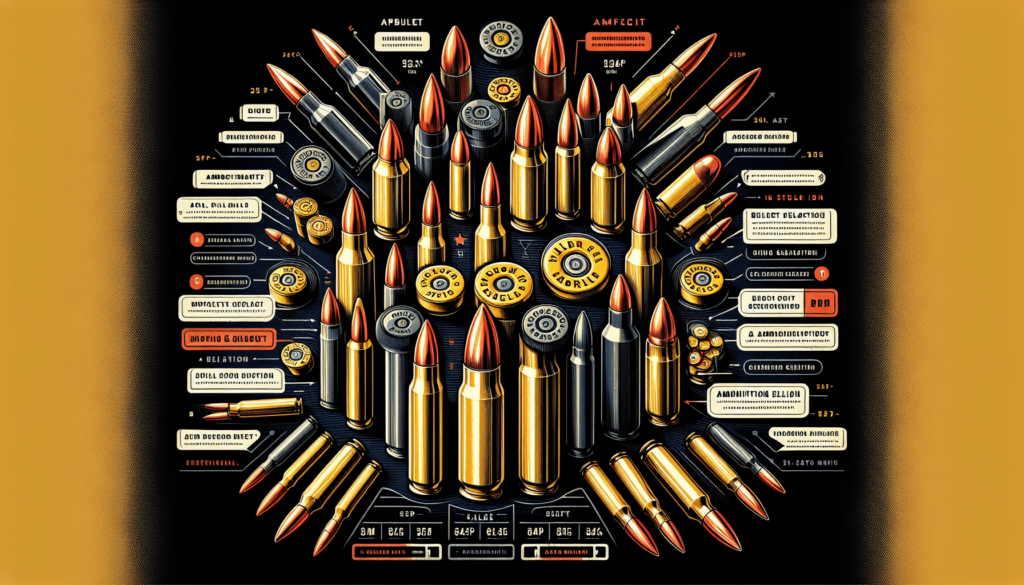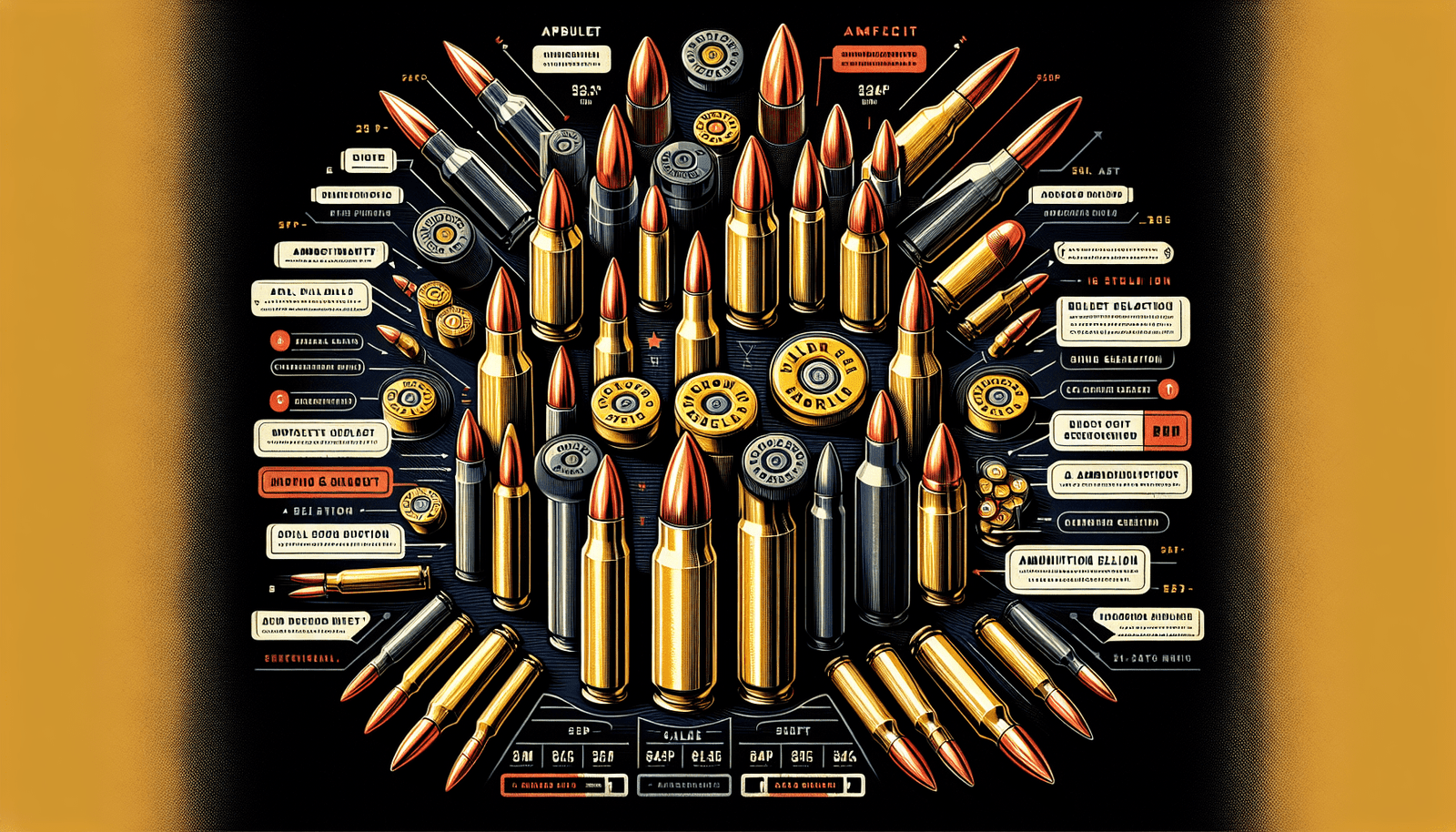Are you a firearm enthusiast? Whether you are a seasoned shooter or just starting out, selecting the right ammunition for your firearm is essential for optimal performance and safety. In this article, you will gain expert advice and guidance on how to choose the perfect ammunition for your specific firearms, ensuring a satisfying shooting experience every time. From understanding bullet types and calibers to considering your shooting purposes, we’ve got you covered. So, let’s delve into the world of ammunition selection and unlock the secrets to maximizing your shooting potential.

Understand the Basics of Ammunition
When it comes to selecting the right ammunition for your firearm, it is crucial to have a solid understanding of the basics. Ammunition comes in various types, each serving a specific purpose. By gaining a deeper understanding of these different types, you can make an informed decision based on your specific needs.
Different Types of Ammunition
The first step in choosing the right ammunition is to familiarize yourself with the different types available. The most common types include handgun ammunition, rifle ammunition, and shotgun ammunition. Handgun ammunition is typically used for pistols and revolvers, while rifle ammunition is designed for rifles. On the other hand, shotgun ammunition is used exclusively for shotguns and offers a wide range of options such as birdshot, buckshot, and slugs.
Understanding Caliber and Gauge
Caliber and gauge are two important terms to understand when it comes to ammunition. Caliber refers to the internal diameter of a firearm’s barrel and the corresponding size of the ammunition it uses. For example, a .45 caliber pistol requires .45 caliber ammunition. Gauge, on the other hand, is specifically used for shotguns and refers to the number of lead balls with the same diameter as the barrel that it takes to weigh one pound. The most common shotgun gauges are 12, 20, and .410.
Ammunition Components
Ammunition is composed of several key components, each playing a vital role in its performance. These components include the case, primer, powder, and bullet. The case holds all the other components together and is typically made of brass, steel, or aluminum. The primer is located in the base of the case and contains a small amount of explosive material, initiating the ignition of the powder. The powder provides the propellant force that propels the bullet down the barrel. Finally, the bullet is the projectile that is fired from the firearm.
Bullet Types
Within each type of ammunition, there are various bullet types designed for different purposes. For example, some common bullet types include full metal jacket (FMJ), hollow point (HP), and soft point (SP). FMJ bullets are typically used for target shooting and training due to their ability to pierce targets consistently. Hollow point bullets, in contrast, are designed to expand upon impact, making them ideal for self-defense as they create greater stopping power. Soft point bullets are often used for hunting as they provide controlled expansion upon impact, maximizing energy transfer to the target.
Muzzle Velocity
Muzzle velocity refers to the speed at which the bullet leaves the barrel of a firearm. It is an important factor to consider when selecting ammunition as it directly affects the bullet’s trajectory, accuracy, and overall performance. Generally, a higher muzzle velocity translates to greater bullet speed and flatter trajectory, making it more effective for long-range shooting. However, it’s important to note that higher velocities may also result in increased recoil.
Energy and Stopping Power
In addition to considering muzzle velocity, it’s important to take into account the energy and stopping power of the ammunition you choose. Energy refers to the force that the bullet carries upon impact, while stopping power refers to its ability to incapacitate the target. Both of these factors are determined by the bullet’s weight and velocity. When weighing your options, it’s crucial to consider the intended use of the ammunition and choose a load that provides sufficient energy and stopping power for your needs.
Consider Your Firearm
Once you have a solid understanding of the basics of ammunition, it’s time to consider your firearm. Your firearm plays a significant role in determining the appropriate ammunition for optimal performance and safety.
Firearm Type and Caliber
The first consideration when it comes to your firearm is its type and caliber. Different firearms are designed to fire specific calibers or gauges, and it’s crucial to choose ammunition that matches the specifications of your firearm. Using the wrong caliber can lead to dangerous malfunctions, poor accuracy, and potential damage to your firearm.
Manufacturer Recommendations
To ensure optimal performance and safety, it’s always a good idea to follow the manufacturer’s recommendations when it comes to ammunition selection. Manufacturers often provide specific guidelines in the user manual or on their websites, outlining the recommended ammunition types, bullet weights, and other factors. By adhering to these recommendations, you can ensure the reliability and longevity of your firearm.
Barrel Length and Twist Rate
The barrel length and twist rate of your firearm can also influence the choice of ammunition. Barrel length affects muzzle velocity, with longer barrels generally resulting in higher velocities. Additionally, the twist rate of the barrel refers to the rate at which the rifling within the barrel spins the bullet. Different bullet weights and designs may require different twist rates for optimal stabilization, accuracy, and performance. It’s essential to consult your firearm’s specifications or seek guidance from experts to ensure appropriate ammunition selection based on your barrel length and twist rate.
Firearm Action
Firearm action refers to the mechanism by which the firearm loads, fires, and ejects cartridges. There are various action types, including semi-automatic, bolt-action, lever-action, and pump-action, among others. Different actions may have specific ammunition requirements or perform optimally with certain types of ammunition. Understanding your firearm’s action and any ammunition restrictions or preferences associated with it will help you select the most suitable ammunition.
Identify Your Intended Use
As ammunition is designed for different purposes, it’s important to identify your intended use when selecting the right ammunition for your firearm.

